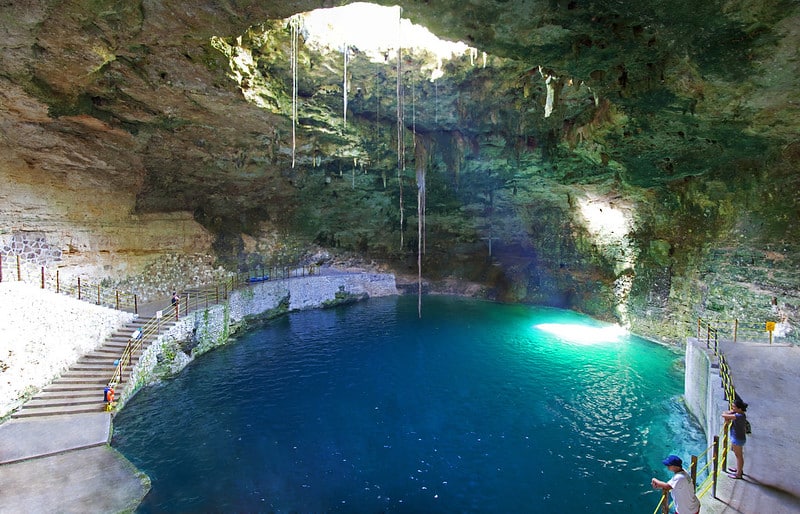Which are better: underground or open cenotes?

Cenotes are unique and stunning geological formations found primarily in the Yucatan Peninsula in Mexico. They are natural sinkholes filled with crystal clear water and are popular tourist attractions for swimming, diving, and exploring. However, with the multitude of cenotes to choose from, visitors are often wondering: what’s best, underground or open cenotes?
Underground cenotes
Underground cenotes, AKA cave cenotes, are located within underground caves and require visitors to swim or dive to access them. These cenotes offer a unique and surreal experience as visitors swim through the dark and quiet cave systems. The lighting inside the caves is minimal, and visitors often come with a flashlight to navigate the cave’s twists and turns. The underground cenotes are usually less crowded than open cenotes, making them a more peaceful and serene experience. Additionally, the temperature inside the caves is cooler, providing a refreshing escape from the heat outside.
Open cenotes
On the other hand, open cenotes sit on the surface and are among lush vegetation and wildlife. They offer a more picturesque and idyllic experience for visitors, with the sun shining down on the crystal clear water. The water in open cenotes is usually shallower and easier to access than underground cenotes, making them a better option for families with young children. Open cenotes also provide visitors with the opportunity to bask in the sun and soak up some vitamin D while enjoying the natural beauty of the surrounding landscape.
Underground or open cenotes: It depends
If you are an avid diver or swimmer looking for an otherworldly experience, then underground cenotes may be the best option for you. If you are seeking a relaxing and serene escape among natural beauty, then an open cenote may be the way to go.
Both options offer a unique and unforgettable experience that you won’t want to miss. So, pack your swimsuit and sunscreen and get ready to explore the breathtaking natural wonders of the Yucatan Peninsula.
Open:
- Ik Kil – Located near Chichen Itza, this open cenote is surrounded by lush greenery and is over 130 feet deep. Visitors can swim, snorkel, or just relax on the surrounding terraces.
Directions: Ik Kil is located about 3 km from Chichen Itza, near the town of Piste. It is easily accessible by car or bus.
- Gran Cenote – This open cenote is located near the town of Tulum and is a popular spot for snorkeling and diving. The water is crystal clear, and visitors can see a variety of fish and turtles.
Directions: Gran Cenote is located about 4 km from Tulum. It can be reached by car or bicycle.
- Cenote Dos Ojos – This open cenote is actually two separate cenotes that are connected by an underground river. Visitors can swim or dive through the interconnected caves and tunnels.
Directions: Cenote Dos Ojos is located about 22 km from Tulum. It can be reached by car or by taking a tour from Tulum or Playa del Carmen.
Underground:
- Cenote Angelita – This underground cenote is famous for its surreal landscape. The water appears to divide in two, with a layer of hydrogen sulfide separating the saltwater and freshwater layers.
Directions: Cenote Angelita is located about 9 km from Tulum. It is accessible by car or by taking a guided tour.
- Cenote Calavera – Locals call it the “Temple of Doom”. This underground cenote has three openings in the ceiling, creating a unique and eerie atmosphere.
Directions: Cenote Calavera is located near Tulum. It can be reached by car or by taking a guided tour.
- Cenote Dos Ojos – This cenote is actually two cenotes that within an underground cave system. The tunnels and caves are famous for their impressive stalactites and stalagmites.
Directions: See directions for the open cenote Dos Ojos.
